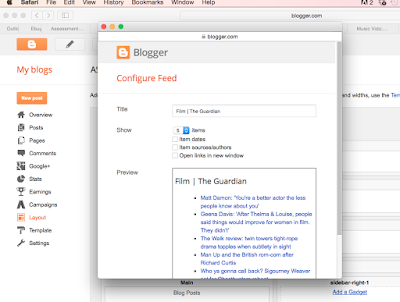When you receive blog comments please make changes within two days; if you're unsure or need help/clarification, please ask! You will be writing up a log of improvements across the year.
FORMATTING + PRESENTATION:
You can find MUCH more detail (and illustrations) in this post.The post title should be short, pithy but clear. This will appear as large bold text, effectively your heading.
Provide clear sub-headings where relevant: adjust size, font, colour, bold.
Don't use underline or colour highlight.
Don't use Courier font.
Remember to highlight terminology with bold + pink.
Add relevant tags ('labels') to your posts.
Round box office up/down to a useful, memorisable figure, using k or m not 000 or 000,000.
Denote quotes of 2+ lines by changing font to Trebuchet, colour purple and clicking speech marks icon to indent. Provide the source; describe in a word or two, make bold - [] are advisable, e.g.: [BritCinema blog post]
More guidance on providing sources, and quoting, here.Provide links as often as possible: if you're blogging on a film, making the film title (the first time you use it in a post) into an IMDB link is useful. If discussing box office, the boxofficemojo.com or the numbers.com link are useful. If quoting an article [source] or [article] are always expected. Always make it clear where your information comes from, even if its not a direct quote.
TIP: When adding images, videos or other embedded material, hit return, type ..., and go back to blank line before pasting in embed code. That will prevent later problems with adding more text. Before formatting a sub-heading or quote add a return/blank line with ... before highlighting text to format. That avoids having to re-format for 'normal' text. Same point for terminology: finish the sentence then format the terminology. If you've forgotten this, just copy some 'normal' text, paste it and type over it.Always give the director, year of release + budget of a film you're analysing. This applies to essays too (budget isn't vital here), eg:
This is England (Meadows, 2006) sparked Warp's first franchise and demonstrates convergence with TV... [I've set this out as I do for quotes]
YOUR BLOG SHOULD HAVE THESE POSTS...
- Analysis of screenshots from [film title] - embed three+ screenshots from a WT DVD; analyse these. At this stage you have limited technical vocabulary, so focus on what you think these tell you about this film. ALWAYS note the director, year of release and budget for any film (box office is also useful).
- This is England - initial notes - we have discussed funding: UK Film Council (what has it changed to?), Film4 etc; who/what Screen Yorkshire + EM Media are Shane Meadows as an auteur; the political viewpoint of the movie and director - the film is autobiographical; Warp as an Indie producer, but also the co-production credits as typical for films at all levels; the budget and box office - the distributor and what their name has changed to;
- Social realism - we explored the two key strands to this film genre, of which TisEng is an example
- This is England - analysis of shots from the opening - by now you're applying specific media language and some semiotic terminology
- Gant on WT topping UK box office with TWO films - what can you learn from Gant's column? I've provided a guide to this; you can't simply copy this, but you can re-use the images I use
- The Gant Rule - what is it; give an example. What does it tell us about the influence of the American market/audience on 'British' film-making?
- [Film Title] + WT's Production Strategies - You have each looked at one WT film's trailer and noted what this might suggest about WT's production strategies, noting aspects such as cast, character ethnicity/class/regional identity, setting/locations, SFX, genre, franchise, reference to other films, prominence of director name, awards. You will add to this detail on the budget and box office, including how many countries it got distributed in, using boxofficemojo.com. Screenshots from trailer and websites used for research should be included - you will be able to use these again in later posts, vodcasts and Evaluation videos.
You should keep adding useful learning on British Cinema to your blog; make use of the images, links and videos i post on my blog - feel free to quote from it too, so long as you clearly denote quotes and identify/provide the source. Your blog contains all your research and planning as you engage in the film-making process, so learning on industry is always useful.
YOUR BLOG WILL SOON HAVE THESE GADGETS...
We will be adding some initial gadgets; you should be adding more as your blog grows. You are marked on Use of ICT, Presentation (of blog), and communication skills; these help with all of these, and will also make your blogs more helpful for you too. I'll detail the what/how/why in another post...
We will be adding some initial gadgets; you should be adding more as your blog grows. You are marked on Use of ICT, Presentation (of blog), and communication skills; these help with all of these, and will also make your blogs more helpful for you too. I'll detail the what/how/why in another post...









No comments:
Post a Comment